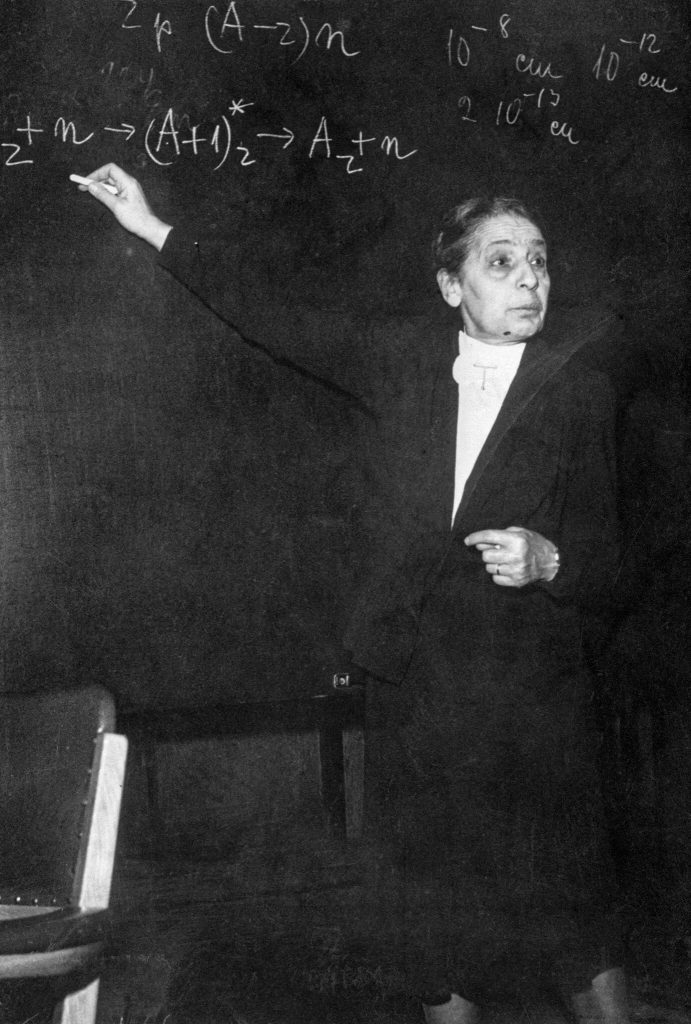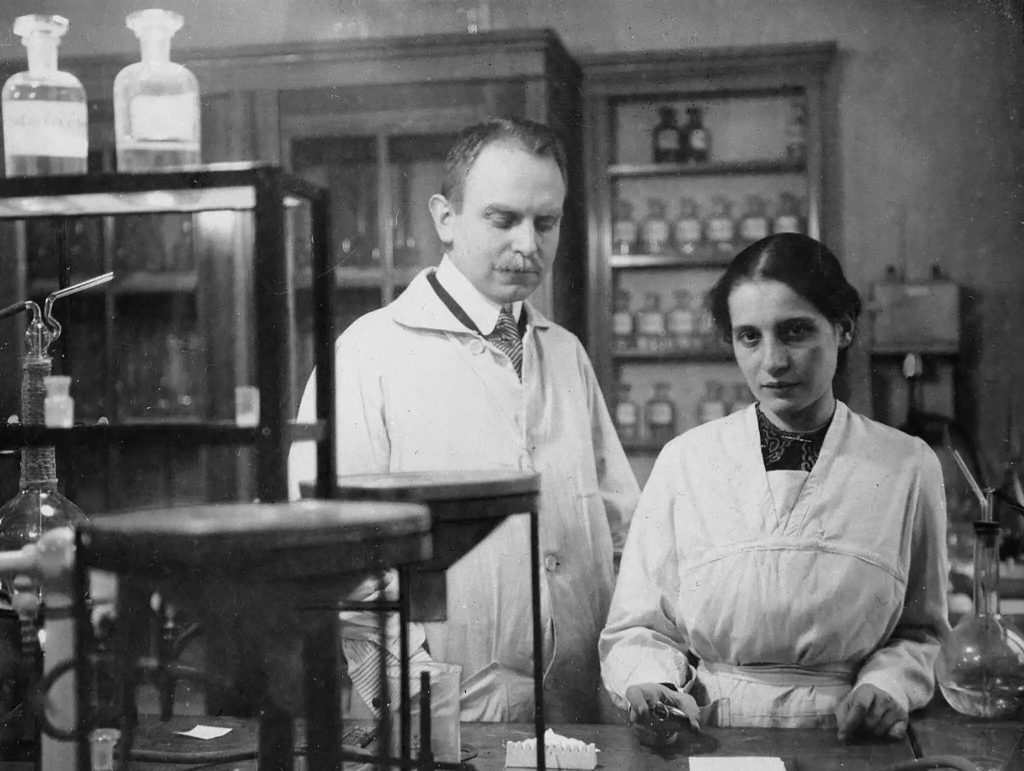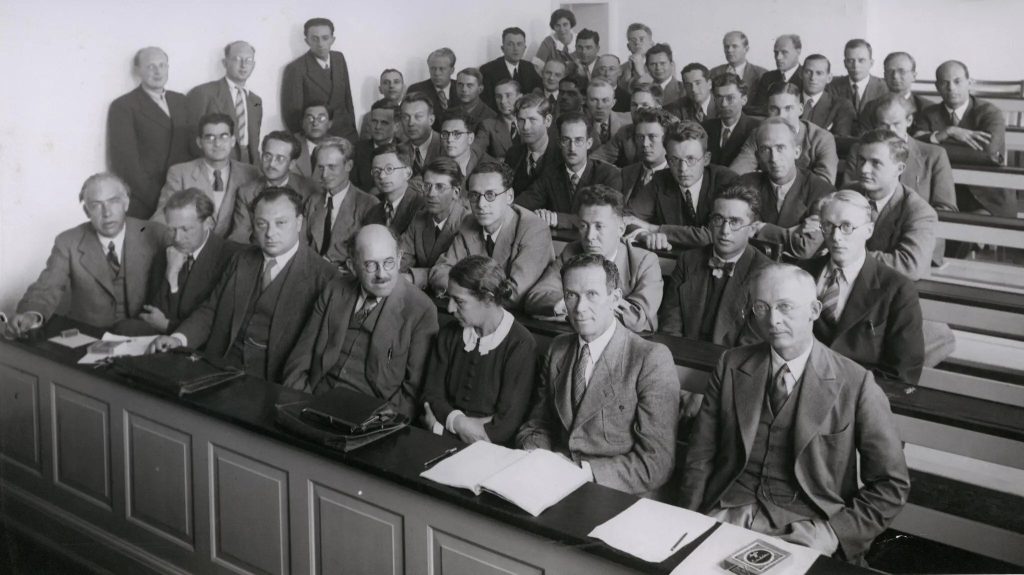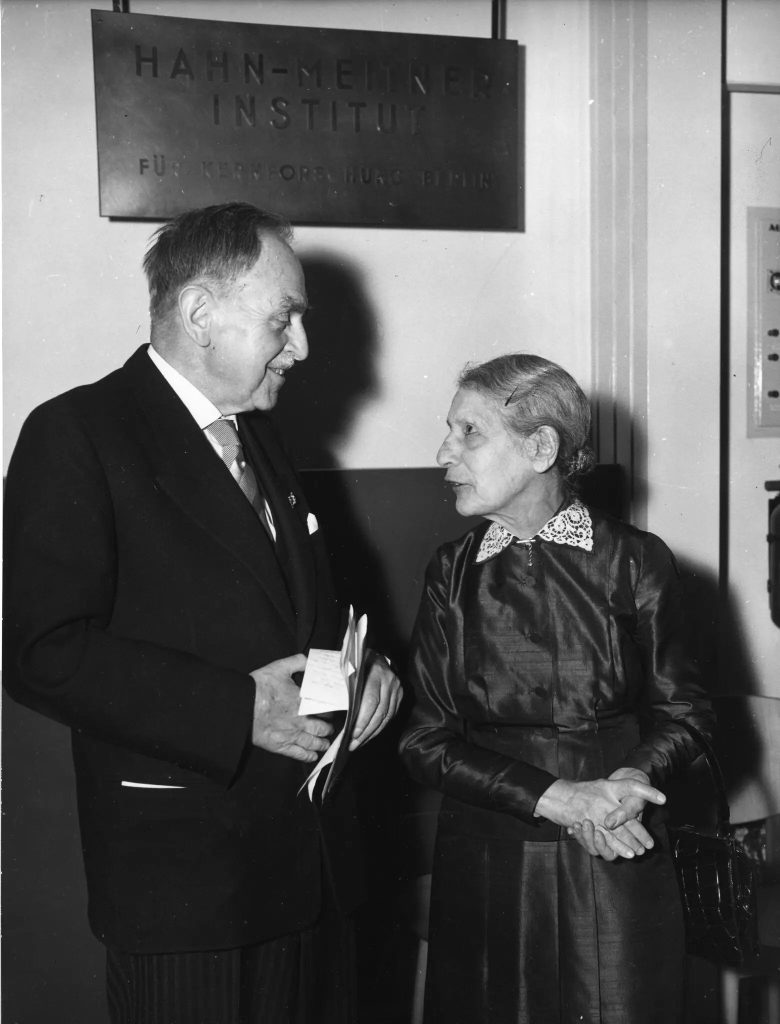Lise Meitner developed the theory of nuclear fission, the process that enabled the atomic bomb. But her identity – Jewish and a woman – barred her from sharing credit for the discovery, newly translated letters show.

Dr. Lise Meitner (1878-1968), the Austrian-Swedish physicist and mathematician, whose work with radioactive isotopes was the key to the development of the Atomic bomb, shown at a chalkboard at the University of Berlin where she lectured as a professor. She was a highly-welcomed guest at scores of scientific conferences.
5 October 2023 — As I have noted, in my writing and film producing about the Holocaust, about the political uses of genocide and massacre, and about anti-semitism, I have done so as a reader and as a “watcher”, not as a true scholar. I have read but a fraction of the Holocaust and genocide literature available in English, which is itself only a fraction of the literature available in Dutch, French, German, Hebrew, Hungarian, Polish, Yiddish, and other languages. Much of the work was not unknown to me. When I became involved in war crime investigation work over 15 years years ago I was introduced to much of this scholarship. But a “scholar” myself? No.
And scores of friends and colleagues have recommended an endless stream of sources, plus their intimate experiences and knowledge. One colleague works at the Bulletin of Atomic Scientists (to which I actually subscribe) and she recommended I read Serving the Reich: The Struggle for the Soul of Physics under Hitler, written by one of my favorite science writers, Philip Ball. And a book unknown to me.
Germany has made colossal contributions to science but it would be hard to argue that, when Hitler came to power, all its scientists were above politics. The behavior of its physicists and chemists is a source of enduring fascination because the discovery of nuclear fission in the German capital on the eve of the second world war could have resulted in handing the world’s first nuclear weapons to Hitler.
The story of physicists under Hitler has been studied frequently and in great depth, though no account has aimed to be quite as comprehensive as this one because it goes into fantastic detail (as do all of Ball’s books) to explain the work of the most prominent physicists (all three Nobel laureates) and how their work intertwined: Max Planck, discoverer of the concept of energy quanta and doyen of German physics in the 1930s and for decades before; Werner Heisenberg, a pre-eminent theoretician in the 1920s and 30s, having been the first to set out a quantum theory of matter; and Peter Debye, a Dutchman whose work on the electrical forces at the heart of matter earned him the sobriquet “master of the molecule”. All 3 of them figure in Christopher Nolan’s recent film “Oppenheimer“ which I reviewed here.
But the real eye-opener was the story about Lise Meitner, the scientist who really developed the theory of nuclear fission (and experiments to prove it) that enabled the atomic bomb, but for which she never received proper public credit.
That, in turn, led me to The Woman Who Split the Atom, The Life of Lise Meitner, the 2022 book by Marissa Moss. The book is incredibly researched and brings Meitner’s life and career back into the spotlight. She was the principal player in the critical scientific discovery of nuclear fission, overlooked by all the men around her (Niels Bohr, Max Planck, and Heinrich Rubens) because she was a Jewish woman. Otto Hahn, her longtime collaborator, won the Nobel Prize in 1944 – for her work.
Yet she was privately credited by the science community with splitting the atom, which led to an invitation to work on the Manhattan Project in the United States to develop the atomic bomb – which she refused.
I was going to write a post this morning to tell her story. But on Tuesday last night Katrina Miller (a well-known science reporter with a Ph.D. in particle physics) published a review and I asked her if I could re-publish it because it is behind The New York Times paywall. What follows is an abbreviated version of Katrina’s review, with a few inserts from me.

Dr. Meitner and Otto Hahn in a Berlin laboratory in the early 20th century
There is a memorable scene in “Oppenheimer”, the blockbuster film about the building of the atomic bomb, in which Luis Alvarez, a physicist at the University of California, Berkeley, is reading a newspaper while getting a haircut. Suddenly, Alvarez leaps from his seat and sprints down the road to find his colleague, the theoretical physicist J. Robert Oppenheimer.
“Oppie! Oppie!” he shouts. “They’ve done it. Hahn and Strassmann in Germany. They split the uranium nucleus. They split the atom.”
The reference is to two German chemists, Otto Hahn and Fritz Strassmann, who in 1939 unknowingly reported a demonstration of nuclear fission, the splintering of an atom into lighter elements. The discovery was key to the Manhattan Project, the top-secret American effort led by Oppenheimer to develop the first nuclear weapons.
Except the scene is not entirely accurate, to the chagrin of some scientists. A major player is missing from the portrayal: Lise Meitner, a physicist who worked closely with Hahn and actually was the one who developed the theory of nuclear fission.
Meitner was a giant in her own right, a contemporary of Nobel laureates like Albert Einstein, Niels Bohr and Max Planck. After the second atomic device was dropped on Nagasaki, the American press dubbed her the “mother of the atomic bomb,” an association she vehemently rejected.
Note to readers: personal peeve. The “mother of the atomic bomb”? Jesus. Some people have such a meager grasp of topics they can only frame women in the terms of motherhood?
Only Hahn won the Nobel Prize for nuclear fission. According to the Marissa Moss book, in his acceptance speech, Hahn referred to Meitner with a German term that means assistant or employee, “or a co-worker at best,” she says.
Moss sifted through Meitner’s entire archive at the University of Cambridge. She then translated hundreds of letters between Meitner and Hahn, written in German, which she says offer a more nuanced perspective of their relationship’s demise. That insight also challenges a common perception that Meitner accepted the outcome of the Nobel Prize without resentment. Not so.
The snub was about more than just gender, according to Moss. “It’s easy to say she didn’t get it because she was a woman,” Moss said. “One doesn’t think a woman is going to make noise about things.” Ms. Moss also believes Meitner’s heritage was at play: “This is a case where it was because she was a Jew.”
In 1947, Meitner wrote to her nephew Otto Robert Frisch, a Jewish physicist who also contributed to the discovery of nuclear fission: “I know that his attitude contributed to the Nobel committee deciding against us,” she said of Hahn, in a letter translated by Moss. “But that is purely private stuff that we don’t want to make public.”
Nobel Week is a moment when the scientific community celebrates its greatest achievements but also, increasingly, examines oversights and injustices. Lise Meitner is one of many women in science who failed to receive due credit for their work, including, perhaps most notably, Rosalind Franklin, the chemist who contributed to the discovery of the double helix structure of DNA in 1953.
“There are hundreds, if not thousands, of women who achieve something great in science that just didn’t get recognized in their lifetime,” said Katie Hafner, the host of the podcast “Lost Women of Science.” Hafner recently completed a two-part episode about Meitner, the second half of which opens with the fateful Oppenheimer scene. Unlike other figures on her podcast, Hafner said, “Lise Meitner is not lost”. But, she added, “she is misunderstood.”
A Radioactive Trailblazer
From the beginning, Meitner was breaking glass ceilings. Born in 1878 in Vienna, she began studying physics privately, as women in Austria were not allowed to attend college until 1897. In 1901, she enrolled in graduate school at the University of Vienna; five years later she earned a doctorate in physics, only the second woman from her university to do so.
Meitner spent the rest of her career working among the greats. She moved to the University of Berlin and began auditing classes taught by Max Planck, who won the 1918 Nobel Prize in Physics – and who generally did not allow women to attend his lectures.
In Berlin, Meitner also met Otto Hahn, a chemist who was around her age and had a more progressive attitude about working with women. Hahn was also eager to collaborate with Meitner, as physicists tended to have a better grasp on radioactivity, the energy emitted by unstable atomic nuclei, than chemists. But, as a woman, Meitner was not allowed upstairs in Hahn’s lab. So she worked – without pay – in the basement. (When she needed to use the restroom, Moss said, Meitner had to dash across the street.)
In 1912, Meitner and Hahn moved to the Kaiser Wilhelm Institute for Chemistry. Together, they discovered a new element named protactinium. When the men at the Institute were drafted during World War I, Meitner was given her own physics lab and the title of professor, a position that granted her recognition and the independence to pursue her own research.
But outside the realm of science, the walls were closing in. Anti-semitism was on the rise, and in 1933 Adolf Hitler was appointed chancellor of Germany. Many Jewish scientists left the country, but Meitner stayed, thinly protected by her Austrian citizenship and keen to hang on to the rare opportunity for a woman to conduct scientific research.
“I love physics with all my heart,” she wrote in a letter to a friend. “I can hardly imagine it not being part of my life.”
In 1938, Germany invaded Austria, leaving Meitner subject to the full extent of the Nazi regime. She opted to flee. The Nobel physics laureate Niels Bohr arranged for her to escape by train.
Meitner eventually made her way to Sweden, devastated at having had to leave behind her life’s work and concerned about the safety of her family.
She continued collaborating with Hahn by mail. He ran her experiments, and she interpreted findings he did not understand. One result stumped them both: When uranium atoms were bombarded with neutrons, the neutron should have been absorbed and an electron released, creating a heavier element. Instead, Hahn found barium, a much lighter element. They were baffled.
The finding was outside of Hahn’s expertise as a chemist. “Perhaps you can come up with some sort of fantastic explanation,” he wrote in a letter to Meitner translated by Ruth Lewin Sime, a chemist at Sacramento City College who published a biography of Meitner in 1996. “If there is anything you could propose that you could publish, then it would still in a way be work by the three of us!” Meitner submitted reams of her work.
Hahn and his colleague Fritz Strassmann submitted all the results for publication in December of 1938. Their tone was uncertain. “There could perhaps be a series of unusual coincidences which has given us false indications,” they wrote in German. They were not really sure of anything.
But … Meitner was not included as an author, nor was there any mention of her contribution to their work.
A Theory Is Born

A lecture in 1937 attended by, from left in front row, Niels Bohr, Werner Heisenberg, Wolfgang Pauli, Otto Stern and Lise Meitner.
In Sweden, Meitner mulled over the results with Frisch, her physicist-nephew. One snowy day, Frisch recalled in a memoir, they took a walk, eventually stopping to sit on a tree trunk and scribble calculations on scraps of paper. Uranium was extremely unstable, they realized, and likely to fracture on impact with, say, a neutron. Those fragments would be violently blasted apart. If one of those pieces were barium, Meitner mused, the other would have to be another light element called krypton. She computed the energy driving the blast using Einstein’s famous equation, E = mc².
“We have read and considered your paper very carefully,” Meitner wrote to Hahn in January 1939. “Perhaps it is energetically possible for such a heavy nucleus to break up.” In a later letter, she expressed disappointment at being absent: “Even though I stand here with very empty hands, I am nevertheless happy for these wonderful findings.” Meitner and Frisch published their theoretical interpretation of Hahn and Strassmann’s results in the February 1939 edition of the journal Nature, correcting what they thought were errors.
They even devised experiments to test their hypothesis of how this would work. In the following weeks, they published two more papers with the results. All the results were conclusive. It became the first physical confirmation of what Frisch coined “nuclear fission.”
Behind the scenes, Meitner and Hahn’s correspondence spiraled into misunderstanding. Hahn thought that she was angry that he had published without her. “What else could I have done?” he wrote to Meitner. “Believe me, it would have been preferable for me if we could still work together and discuss things as we did before!” Hahn was also receiving pushback for working with a Jewish scientist. “I don’t give these things much weight, of course, but didn’t want to confess to the gentlemen that you were the only one who figured out everything immediately,” he wrote Meitner in 1939.
Later that year, Germany invaded Poland. World War II had begun. And the race was on to build an atomic bomb. Word spread about nuclear fission. Though a single split atom did not generate enough energy for potential use in a weapon, some speculated that a chain reaction could do the trick. Bombarding uranium with neutrons not only produced lighter elements; it also created more neutrons. If those neutrons collided with more uranium, the reaction might sustain itself. The American government assembled the Manhattan Project to develop such a weapon. Many of Meitner’s peers, including Frisch and Bohr, became involved. Einstein did not, although he had written a letter to President Franklin D. Roosevelt urging him to secure uranium and fund chain reaction experiments.
Meitner, though she had been invited, refused to join. (“I will have nothing to do with a bomb!” she famously said.)
In 1945, after atomic bombs were dropped on Hiroshima and Nagasaki, leading to the end of the war, some newspaper stories claimed that Meitner had smuggled the recipe for the weapon out of Nazi Germany in her purse. She dismissed them. “You know so much more in America about the atomic bomb than I,” she told The New York Times in 1946.
In 1945, Hahn was nominated for the 1944 Nobel Prize in Chemistry, one year late due to the war, for the discovery of nuclear fission. Meitner and Frisch were also nominated for the physics prize that year. But only Hahn won. People in the know were not surprised.
A “Firm Tradition”
Details of Nobel Prize deliberations remain secret for 50 years after an award is given. After the documents surrounding Hahn’s win were released, science historians published an analysis of the deliberations in Physics Today in 1997. “None of this embittered Meitner,” they wrote. “She complained very little, and forgave a great deal.”
Hafner takes issue with that stance. “Who is going to say, ‘Hey, I’m bitter’?” she said. “What are the optics of that?” Moss thinks bitter is the wrong word. “She was very, very hurt,” she said of Meitner, at both the lack of credit and the passive loyalty she felt Hahn stil had to Germany. “It was quite clear to me that Hahn was completely unaware of his unfriendly behavior,” Meitner wrote to a friend in 1946. “Naturally, the time together with him was somewhat painful, but I was prepared for it and held myself firm, bringing up no personal debates.”
Note to readers: Meitner was nominated again – five times – for the 1946 Nobel Prize in Physics. According to the authors of the “Physics Today” article, the Nobel committee argued that it was “firm tradition” to award the prize for experimental, rather than theoretical, discoveries. Yet it was Meitner who had developed the experimental discovery for nuclear fission, not Hahn.
Demetrios Matsakis, a retired physicist of the U.S. Naval Observatory, said it is simply impossible to separate the “interplay between experimentalists and theorists. They need each other.” (Dr. Matsakis learned of Meitner in 2018, and was inspired to petition to rename another radioactive process, to recognize Meitner’s role in that discovery.) Hahn deserved the award, but Meitner did, too, Dr. Matsakis said: “She should have gotten the Nobel Prize. There’s really no question about that.” As an inverse comparison, scientists note the case of Chien-Shiung Wu, a female Chinese American physicist who ran experiments showing that some particle interactions do not obey mirror symmetry. In 1957, two of Wu’s male colleagues won the Nobel Prize in Physics for building the theory confirmed by her results. But not her. The award recipient – the experimentalist or the theorist – “seems like it was reversed in these two cases,” said Harry Saal, a physicist who studied under Wu at Columbia University. “And in both cases the woman got screwed.”
Memorializing Meitner

Meitner with Otto Hahn in 1959, to inaugurate the Hahn-Meitner-Institut Berlin, now the Helmholtz-Zentrum Berlin.
In his later years, Hahn seemed to try to make amends. He and Meitner remained friends, and he offered her a head position at the Max Planck Institute in Germany, which she declined. In 1948, he nominated her for the Nobel Prize in Physics.
Meitner went on to be nominated 46 times for the Nobel in both physics and chemistry, but she never won. (To date, only four women have won in physics, most recently in 2020, and only eight have won in chemistry.)
Note to readers: in 1968, Meitner, then 89, died in England. An obituary that ran in The Times referred to her as an “atomic pioneer” and the “scientific partner of Otto Hahn, the Nobel Prize-winning nuclear chemist and the discoverer of nuclear fission”. People in the know groaned. The Times was pounded with irate letters.
In 2020, the official Nobel Prize account on X, formerly known as Twitter, acknowledged that both Hahn and Meitner discovered nuclear fission. The post was accompanied by artwork showing Meitner standing behind Hahn, to the outrage of many people.
Any effort to award a Nobel to Meitner posthumously would be in vain. “Once a Nobel is given, there is no going back,” Dr. Sime said. The best that can be done is to acknowledge Meitner in the present, she added — and her omission from the new Oppenheimer film “was not excusable.”
Moss is still translating Meitner’s letters; so far, she has worked through more than 700 pages. “Now I’m just doing it because I fell in love with her,” she said. “She’s an incredible person.” She plans to write another book about Meitner with all the material that did not make it into the first one.
Earlier this year, Hafner and a friend visited Meitner’s grave, located in a tiny English churchyard “in the middle of nowhere,” she said. It took them half an hour to find the faded tombstone, which was overgrown with weeds.
Hafner was surprised at how unremarkable the grave was for such “a giant in science,” she said. Still, she was comforted to find a stone perched atop the marker, a Jewish practice to honor the dead. Hafner added visitation stones for herself, Moss, Bohr, Einstein, Frisch and even Hahn.
This is how people are remembered, Hafner said. “Until we chip away at this and continue to remind people of the important work she did, it just won’t get recognized,” she added. So “we do everything we can to set the record straight.”